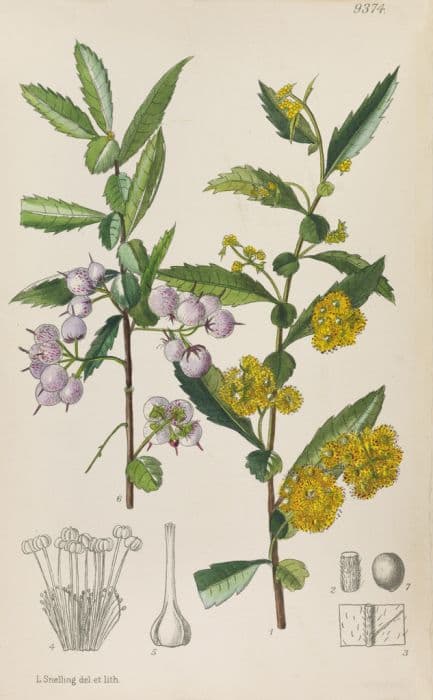Magnificent Willow Salix magnifica

ABOUT
Salix magnifica, commonly referred to as magnificent willow, is a visually impressive species with notable features. The most striking aspect of its appearance is the large, elongated leaves that can sometimes be unusually wide compared to other willow species. These leaves have a deep green color that glistens in the sunlight, due to their glossy texture, and they usually boast a finely serrated edge that adds to the overall elegance of the foliage. During the spring, the magnificent willow displays catkins, which are long, fluffy, and typically silvery or yellowish in tone, providing a contrast that is quite eye-catching against the lush greenery. This display of catkins is particularly prominent before the leaves fully unfold. The bark of the magnificent willow is another defining characteristic, typically exhibiting a smooth texture and a greyish-brown color that may become rougher and more fissured with age. The overall shape of the plant can be quite rounded or spreading, giving it a bushy and full appearance, with branches that can sometimes droop gracefully. This contributes to the elegant and stately presence for which the magnificent willow is named. The combination of these features, from the distinctive foliage to the catkins and the overall habit, makes the magnificent willow a notable and attractive addition to any setting where it is found.
About this plant
 Names
NamesFamily
Salicaceae
Synonyms
Magnificent Willow
Common names
Salix magnifica.
 Toxicity
ToxicityTo humans
Salix magnifica, commonly known as the magnificent willow, is not typically recognized for significant toxicity to humans. Willows generally contain salicin, a precursor to salicylic acid (a compound similar to aspirin), which could cause mild stomach upset or more serious conditions in very large doses such as Reyes syndrome in children. However, there are no well-documented cases of poisoning from the magnificent willow specifically. As with any plant, individual allergies can occur, and it is advised to avoid ingesting parts of any plant not known to be safe.
To pets
Salix magnifica, commonly known as the magnificent willow, is typically safe for pets. Willows are known to contain salicin, which can be mildly toxic in large quantities but is generally not a concern in normal exposure. If a pet ingests large amounts of the magnificent willow, it could potentially cause gastrointestinal upset, such as vomiting or diarrhea, or more serious issues if consumed in very large quantities. It is always best to prevent pets from consuming non-food plants to avoid the possibility of stomach upset or other potential reactions.
 Characteristics
CharacteristicsLife cycle
Perennials
Foliage type
Deciduous
Color of leaves
Green
Height
20-30 feet [6-9 meters]
Spread
15-20 feet [4.5-6 meters]
Plant type
Tree
Hardiness zones
7
Native area
China
Benefits
 General Benefits
General Benefits- Erosion control: Salix magnifica, commonly known as the magnificent willow, is effective in stabilizing soil and preventing erosion, especially along riverbanks and sloped areas.
- Habitat for wildlife: The magnificent willow provides a natural habitat for birds and other wildlife, offering food and shelter.
- Aesthetic appeal: With its striking appearance, the magnificent willow adds beauty and character to gardens and landscapes.
- Shade provider: The expansive canopy of the magnificent willow offers ample shade, making it ideal for use in parks and large gardens.
- Windbreak: The dense foliage and robust growth of the magnificent willow make it suitable for use as a windbreak to protect against strong winds.
- Noise reduction: When planted in groups, the magnificent willow can help dampen noise pollution, making it a good choice for urban and suburban planting.
 Medical Properties
Medical PropertiesThis plant is not used for medical purposes.
 Air-purifying Qualities
Air-purifying QualitiesThis plant is not specifically known for air purifying qualities.
 Other Uses
Other Uses- Landscaping: Salix magnifica, commonly known as magnificent willow, is often used in ornamental gardens for its stately appearance and large, shiny leaves.
- Erosion Control: Due to their robust root systems, magnificent willows can help stabilize soil and prevent erosion on riverbanks and slopes.
- Biomass Production: The rapid growth of magnificent willow makes it a good candidate for biomass production, providing renewable energy from plant material.
- Basket Weaving: Traditionally, the flexible branches of willows, including those of Salix magnifica, can be used in the craft of basket weaving.
- Shelterbelts and Windbreaks: Planting rows of magnificent willow can protect smaller plants from strong winds and help reduce the impact of storms on properties.
- Habitat Creation: Salix magnifica provides shelter and food for various wildlife species, enhancing biodiversity in gardens and natural settings.
- Noise Reduction: When used as dense hedges, magnificent willows can act as natural sound barriers to reduce traffic or other noise pollution.
- Art and Sculpture: The wood and branches of Salix magnifica can be used in artistic works, including live plant sculptures and installations.
- Privacy Screens: Due to their size and density, magnificent willows can be strategically planted to create natural privacy screens for homes and gardens.
- Culinary Experiments: While not a traditional edible plant, some adventurous chefs may use parts of the magnificent willow, like the young shoots, to add a unique flavor or garnish to dishes, provided they are non-toxic and safe for such use.
Interesting Facts
 Feng Shui
Feng ShuiThe Salix magnifica, commonly known as the Magnificent Willow, is not used in Feng Shui practice.
 Zodiac Sign Compitability
Zodiac Sign CompitabilityThe Magnificent Willow is not used in astrology practice.
 Plant Symbolism
Plant Symbolism- Flexibility: Much like other willow species, Salix magnifica, commonly known as the Magnificent Willow, symbolizes flexibility due to its supple branches that bend without breaking.
- Adaptability: The Magnificent Willow can grow in various conditions, representing the ability to adapt and thrive in different environments.
- Growth: The lush growth of Salix magnifica represents personal growth and the capacity for renewal, much as the willow tree sprouts new leaves each spring.
- Survival: Its ability to survive and even propagate from broken pieces is emblematic of resilience and survival against the odds.
- Healing: Historically, willow bark has been used for its medicinal properties, so the Magnificent Willow is associated with healing and relief from pain.
- Graciousness: The elegant and serene appearance of the Magnificent Willow can symbolize graciousness and calmness in one's demeanor.
 Water
WaterThe Magnificent Willow, commonly known as Salix magnifica, should be watered thoroughly, ensuring that the soil is consistently moist but not waterlogged. During the growing season, it may need to be watered with about 2 gallons per week, depending on the environmental conditions. In hotter seasons, this frequency may increase to ensure the soil does not dry out completely. In the winter months, reduce watering to avoid root rot but don't let the soil become completely dry. Always check the top inch of the soil for dryness before watering to prevent over-watering.
 Light
LightThe Magnificent Willow does best in full sun to partial shade. It thrives when it receives at least 4 to 6 hours of direct sunlight per day. Ideally, place it in a spot where it gets morning sun and some afternoon shade, as too much intense afternoon sun could be harmful. It’s adaptable to different light conditions, but it should always get a good amount of natural light.
 Temperature
TemperatureThe Magnificent Willow is hardy and can tolerate a wide range of temperatures, but it grows best in conditions between 70 and 80 degrees Fahrenheit. It should be protected from extreme temperatures, with a maximum limit of around 90 degrees Fahrenheit and a minimum of about 50 degrees Fahrenheit to prevent damage to the plant.
 Pruning
PruningPruning the Magnificent Willow is best done during late winter or early spring before new growth begins. This encourages a healthy structure and removes any damaged or diseased branches. Thin out old branches to allow light and air to penetrate the canopy, which helps promote new growth. Prune sparingly, as excessive cutting can lead to shock and less foliage production.
 Cleaning
CleaningAs needed
 Soil
SoilThe Magnificent Willow (Salix magnifica) prefers consistently moist, well-draining soil. A mix of loam, peat, and sand in equal parts can create an ideal environment. The soil pH should be slightly acidic to neutral, ranging from 6.0 to 7.0.
 Repotting
RepottingMagnificent Willows typically do not need repotting often, as they are generally planted directly in the ground. If grown in a container, repot every 2-3 years or when rootbound.
 Humidity & Misting
Humidity & MistingMagnificent Willow favors high humidity levels. Aim to maintain a humidity level of 60% or higher to simulate its native, moist conditions.
 Suitable locations
Suitable locationsIndoor
Keep moist, provide bright light, increase humidity.
Outdoor
Plant in moist area, shelter from wind, partial sun.
Hardiness zone
7-9 USDA
 Life cycle
Life cycleSalix magnifica, commonly known as the magnificent willow, begins its life cycle with seed dispersal, which often occurs through wind or water due to its lightweight. Upon finding a suitable moist and sunny habitat, the seeds germinate, and seedlings start to establish, developing a primary root and initial leaves. As the seedlings mature into saplings, they undergo rapid growth, with stems elongating and leaves expanding to maximize photosynthesis. During its adult phase, the magnificent willow reaches reproductive maturity and produces catkins, which are flowering inflorescences that facilitate pollination by insects or wind. Following successful pollination, seeds are developed within capsules that, once mature, open to release the seeds, continuing the cycle. Finally, after many years, the plant will enter senescence, where growth slows, and it eventually dies, contributing organic matter back to the ecosystem.
 Propogation
PropogationPropogation time
Spring
Propogation: Salix magnifica, commonly known as the Magnificent Willow, is best propagated during the dormancy period, which is typically from late winter to early spring before the new growth begins. The most popular method of propagation for this plant is through hardwood cuttings. This involves taking a 6 to 8-inch cutting (15 to 20 cm) from a healthy, mature stem during the dormant season, making sure the cutting has at least a couple of buds. The lower end of the cutting is then dipped in rooting hormone to encourage root development and planted in a well-draining soil mix. Keeping the soil moist but not waterlogged is essential for the cuttings to take root. This method is effectively used because it maintains the genetic fidelity of the parent plant and young willows often root easily, making for a straightforward and successful propagation method.









